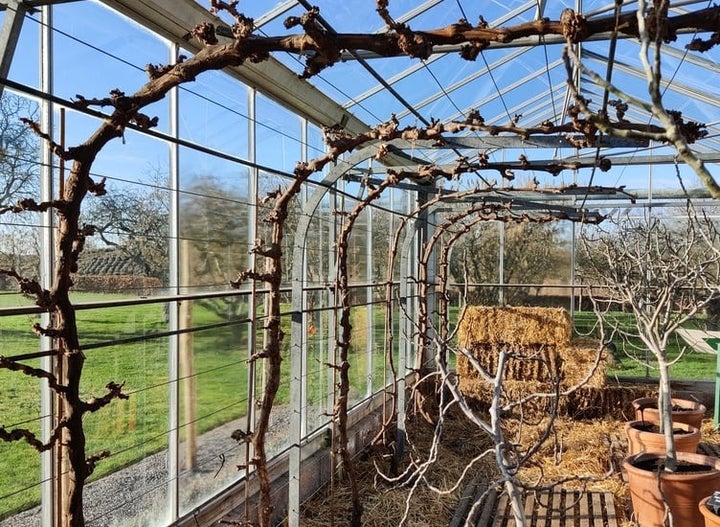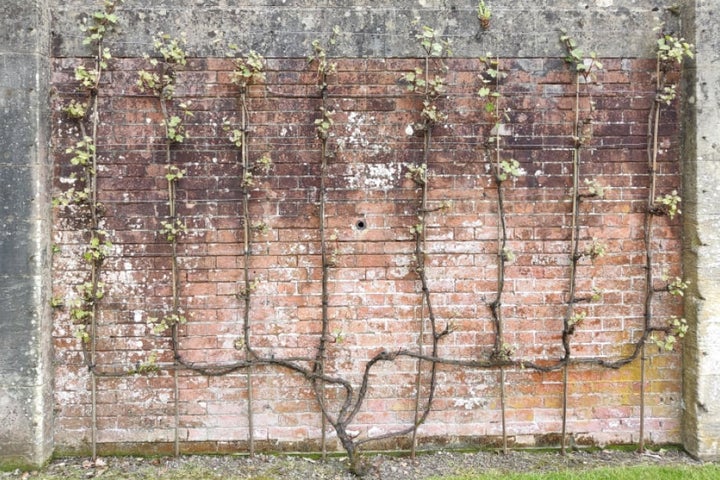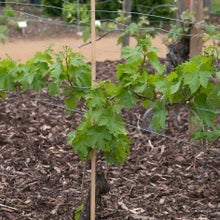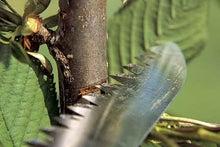
Quick facts
The two main training methods are the Guyot and the rod and spur (or cordon) systems
Depending on the cultivar, grapevines can be grown outdoors or under cover
They need a permanent support
The main pruning season is when fully dormant in early to mid-winter
Pruning after mid-winter will lead to sap bleeding
Further training and pruning is needed during spring and summer
Main training methods
Grapevines, whether grown for dessert fruit or wine-making, either under cover or outdoors , need regular pruning and training to keep them under control and producing good harvests.
The two main options are the rod and spur system and the Guyot system. In a small space, you could also grow a vine in a more compact ‘standard’ form. Which method you choose will depend mainly on how much space you have and where you want to grow your vine(s).
Pruning and training should be started in the first winter after planting the vine, then continued consistently every year. It will take two to four years before you get your first bunch of grapes, once the vine is well established.
Rod and spur system
Also known as training, this method is very versatile. It’s the best choice for growing grapes in a greenhouse and is also well suited to outdoor vines trained against a wall or fence, or over an arch or pergola. The vine is trained to form a permanent framework with a single or multiple stems, to suit its particular location. The new fruit-carrying shoots growing from the permanent stem(s) need to be pinched back in summer and pruned in winter.

Guyot system
Guyot training is widely used in vineyards, both large and small, for outdoor dessert and wine grapes. But it’s also suitable for vines in gardens and allotments. It’s a ‘renewal training system’, based on either one or two fruiting ‘arms’ (horizontal branches) growing from a short permanent main stem (single or double Guyot, accordingly). After fruiting, the arm(s) are removed annually and shoots that formed the previous season are trained to replace them.

Standard
If space is limited, you can train an indoor or outdoor grapevine as a standard. This has a single stem with a head of branches at the top, like a lollipop. It’s ideal for containerised plants and makes an attractive garden feature. However, you will only get a modest crop.
For full details of these methods, see our guides:
When to prune and train
- Early winter (late Nov/Dec) is the main pruning time. Pruning later than this can cause the cuts to bleed sap , which can weaken the plant. starts to flow earlier in greenhouse grapevines, so it’s particularly important to complete their pruning in early winter. In sites prone to spring frosts, you could consider delaying pruning until early spring – see FAQs, below
- Spring and summer – train and trim back new shoots, and thin out the fruit if necessary

Supporting grapevines
No matter where you grow your grapevine(s) or which training method you use, you need to install permanent support. See our pruning guides for full details:
Frequently asked questions
Why did my grapevine bleed after pruning?
If pruned late, in January or beyond, when the is starting to rise, grapevines are prone to bleeding sap from pruning cuts. This particularly affects plants growing in a greenhouse or if you make large pruning cuts into older wood. There is nothing you can do to halt the – it will stop naturally when the vine starts growing. In future years, finish pruning by mid-winter.
My grapevine’s new shoots often get damaged by frosts – should I delay pruning?
Yes, in sites prone to frost in spring, delay pruning until March or early April, so the burst later and new shoots are less likely to be hit by frost. The resulting bleeding won’t usually have a significant effect on a healthy vine. However, if you want to make any larger cuts into older wood, do it when the vine is fully , by the middle of winter.
More on pruning grapevines
The following 911���� books are widely available to buy, or can be borrowed by 911���� Members from the 911���� Lindley Library :
- Grapes: indoors and out by Harry Baker and Ray Waite
- 911���� Pruning & Training by Christopher Brickell & David Joyce
Also see our pruning guides:












